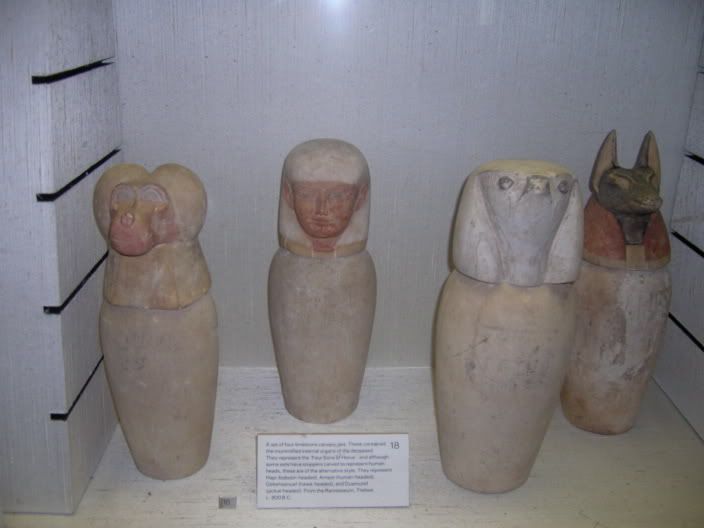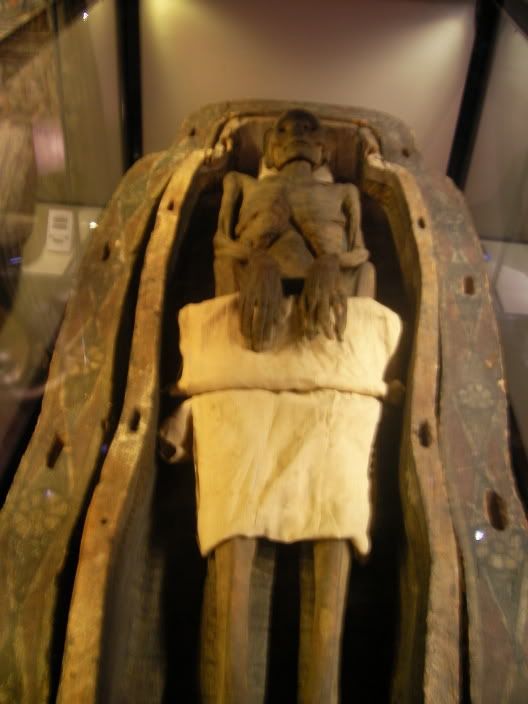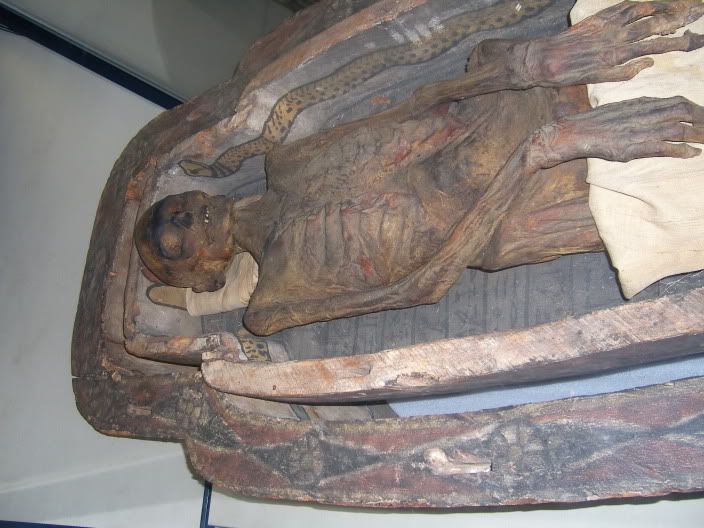The purpose of mummification to the ancient Egyptians was as a preservation method. During pre-dynastic times Egyptian people used to bury their dead in the desert, in sand pits, where the desert naturally dehydrated the remains, causing the bodies to mummify naturally. However, they noticed that often the deceased would end up being dug up by wild animals; such as jackals, and so they began lining the pits in bricks and laying the deceased upon woven mats; later wrapping the bodies in the mat or even interring their dead in coffins. These changes removed the bodies from direct contact with the naturally drying sands which caused the bodies decay. This didn’t go unnoticed by the Egyptians, and it prompted the idea of applying resins as a way of preservation.
An important point in mummification was that the features of the dead needed to be recognisable, as in the Egyptian's religion the ka (a person’s spiritual double that continued to live on in the tomb and offering chapel of the deceased) needed to be able to recognise the body so that it had somewhere safe to reside, and the deceased could therefore continue to exist forever in the afterlife. Not much is known about their mummification techniques from when it began in the Old Kingdom, as mummies are rarely discovered from this period. Although, there is some indication that before mummification was perfected, a type of cast was sometimes made by soaking linen in resin which was sculpted and placed upon the body, rather than the body being wrapped.
[Above - Limestone Canopic Jars from the Ramesseum 800 BC (23rd dynasty), taken at the Manchester Museum UK.]
The removal of organs to be preserved outside the body started fairly early on in their mummification techniques, as it was a way of further preventing the body from decay. These particular organs - usually the lungs, stomach, intestines, and liver - started out by being stored inside a chest containing separate compartments, or in niches in the burial chamber wall. During the First Intermediate Period and the Middle Kingdom, limestone or alabaster canopic jars were made to hold the organs, and these jars where then often stored inside the chest. They each held one of the four preserved organs and were closed with human-headed lids (earlier jars had flat-topped lids). At the beginning of the 19th dynasty, the human-headed lids were replaced by animal-heads representing the Four sons of Horus [see picture above], whom were believed to magically protect these organs. The baboon-headed jar represented the god Hapi and held the lungs, the human-headed jar represents Imsety and held the liver, the intestines were held by the falcon-headed god, Qebehsenuef, and the stomach was kept in the jackal-headed jar representing Duamutef. When, in the 21st dynasty the practice of replacing the preserved organs back into the abdominal cavity began, people sometimes still had dummy canopic jars interred with them so that their organs could still be symbolically protected.
King Ahmose (I), founder of the 18th dynasty, is the first person that is known to have had his brain removed, but it wasn’t removed using the methods that became customary later in the New Kingdom (out through the nasal passage); he had his removed by taking out the Atlas vertebrae (uppermost of the seven cervical vertebrae; called the 'Atlas' because it supports the globe of the head). They made efforts to usually remove the brain, and unlike many of their other internal organs, they didn’t preserve it in any way. The ancient Egyptians didn’t regard the brain as being in control of people's thoughts, knowledge, and emotions; these were considered to be a function of the heart. When a person felt sad, excited, or angry they noticed that it was the heartbeat that changes, and this was why the Egyptians thought that the heart was in control of thoughts and emotions. The heart was also considered the seat of wisdom and knowledge, which was why the heart was weighed against the feather of Ma'at in Chapter 125 of the Book of Coming Forth by Day, as it served the purpose of ensuring that the deceased's heart wasn't weighed down by sin before he was admitted into the afterlife. The importance of the heart was also shown by them with the heart scarabs that were wrapped in the bandages and were inscribed with Chapter 30B from the Book of Coming Forth by Day; which asks the heart not to speak out against him during the judgement (in other words; not to speak of the deceased's sins). This all shows that the brain wasn't thought very highly of in comparison to other organs; especially the heart, where sometimes heart-shaped amulets were even used to replace the heart if it had become damaged during the mummification.To make a mummy appear more lifelike the mummified remains could be painted or coated in resin; as in the case of Sethy (I), whose features are extremely striking. Hair was sometimes dyed with henna to resemble the colour it originally was in their youth, or sometimes the head was shaved and wigs were provided. The New Kingdom also brought the introduction of stuffing the body to make it more lifelike, and onions or stones are known to have been used to fill out the eye sockets to give a more pleasant appearance. During the Late Period mummification techniques became much more shoddy, but the actual wrapping of the body became more advanced and became an art form in itself; admired more for its creative value rather than its purpose. Funerary masks were even made for those that could afford them in case the body became damaged or wasn’t aptly recognisable to the ka. For the pharaohs these masks were made from metals like gold, silver, or bronze, but for the rest that had them they were usually made from cartonnage which was often painted, or covered in gold leafing, and sometimes inlayed with jewels. The idea of using funerary masks originated in the Old Kingdom when the whole body was often coated in plaster to preserve the likeness of the individual: the head was moulded separately which introduced the idea of the funerary mask.



